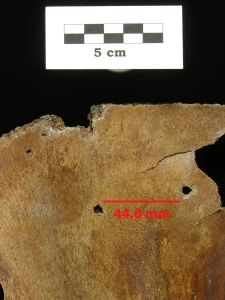In July of 1987 Dr. Louis D. Rodabaugh reported the discovery on his land of the bones of an extinct Stag-moose (Cervalces scotti) while excavator Ron Grable was digging a pond in Rodabaughs back yard near Hartville in Stark County. Forty-nine bones plus 5 bone fragments were recovered, including much of the skull, 13 leg bones, pelvis, both scapulas and a number of ribs and vertebra. This makes the skeleton roughly 40 to 50% complete. Dr. Rodabaugh donated the bones to the Ohio Historical Society, and in 1993 when the Nature of Ohio exhibit opened, many of the bones were placed on display where they remain today. We eventually obtained radiocarbon dates from one of the bone fragments, dating the specimen to 11,795 BC. Dr. H. Greg McDonald and Dr. Russell Graham both indicated that at the time this was the only confirmed female Cervalces skeleton, adding to its significance. In Ohio, we now have records for 11 specimens of Cervalces but all but three of these consist of only 1 to 3 bones.
 Stag moose scapula with visible canine punctures.
Stag moose scapula with visible canine punctures.
Examination of the bones showed that other than the five small fragments, and broken thin edges of the two scapulas, the bones were in virtually pristine condition. However, recently while examining carnivore chew marks on bones of another, more recent Stag-moose discovery, I started noticing detail that either none of us noticed before, or at least never reported. As mentioned above, the two scapulas appear broken on the distil margins, but close examination reveals tooth marks several small punctures to the thin bone of the scapula near the broken edges which appear to have been made by a carnivores canine teeth. Most of these are solitary tooth marks, and only reflect the very tip of the tooth, so there is no sense of how large the carnivore was. However, the left scapula (see photo) has a distinct pair of two canine punctures. These measure 44.0 mm apart. Could we determine what carnivore made these? In 2008, a paper by Jennifer Hodgson and others examined the taphonomy (the study of the processes [as burial, decay, and preservation] that affect animal and plant remains as they become fossilized) of tooth marks, drag marks, trampling marks and other marks left on bones of a mastodon in New York State. Within their report they include a table showing average canine diameters and distances between canines for several common, Pleistocene carnivores. According to their list, the 44.0mm distance between the tooth marks on our Cervalces would be greater than any of four modern day wolf canines (Canis lupus, 34.09 to 38.18 mm) and even greater than the single black bear (Ursus americanus) they examined (40.59mm). Using bones in the natural history collections of the Ohio Historical Society, I was able to add to their sample three more wolves (30.9 to 35.2 mm) and six more black bears (33.3 to 46.9 mm). So the canine pair marks on the left scapula of the Rodabaugh Stag-moose could not have been made by a modern wolf, but might have been made by a black bear. Hodgson and her co-authors also provide data from a single specimen of the extinct dire wolf (Canis dirus) giving a distance between the canines at 51.11 mm. Given the fact that wolves may vary greatly in size, it is possible the Rodabaugh Stag-moose was chewed on by a small dire wolf, or a black bear, or some other similar sized carnivore we have yet to determine. The slight damage to both scapulas, with virtually no damage to other recovered bones posses a new question. Why would any carnivore chew only on the distil end of the scapula, but not on any other bones? Typically wolves and other carnivores are eager to break open the long leg bones to get the fatty marrow out of them. When feeding on a carcass, the first parts to be torn off are the front legs. The humerus is especially attractive, with wolf gnawing starting on the upper (proximal) end, and eventually (if the carnivore is big enough and the prey small enough) breaking into the humerus for the marrow. When the front leg is separated, it could be at the joint between the scapula and the humerus, or the entire leg with the scapula might be torn off. I can envision our unidentified carnivore (or several of them) pulling off first one front leg, then another and hauling them a few yards away to feast in privacy while other carnivores or scavengers feasted on the large muscles of the rest of the carcass. While carrying the legs, perhaps they grabbed it by the end of the scapula and pulled, leaving impressions of their canines. Perhaps there was even a tug of war between two carnivores, with the second pulling where flesh and bone was thick enough to not leave any tooth marks, compared with the very thin edge of the scapula. Either there was a lot of prey available so the carnivores did not need to consume every part of the carcass, or something scared them off before they could continue feasting. Perhaps a spring thaw dropped the carcass into the previously frozen lake bed before they could finish their work. That piece of information will need to remain conjecture. But we have a fairly narrow list of potential carnivores that could have been consuming our Stag-moose: black bear or dire wolf being the most likely suspects in our Pleistocene Crime Scene Investigation. By Bob Glotzhober, Senior Curator, Natural History Photos courtesy of Bill Pickard, OHS Archaeologist For further reading